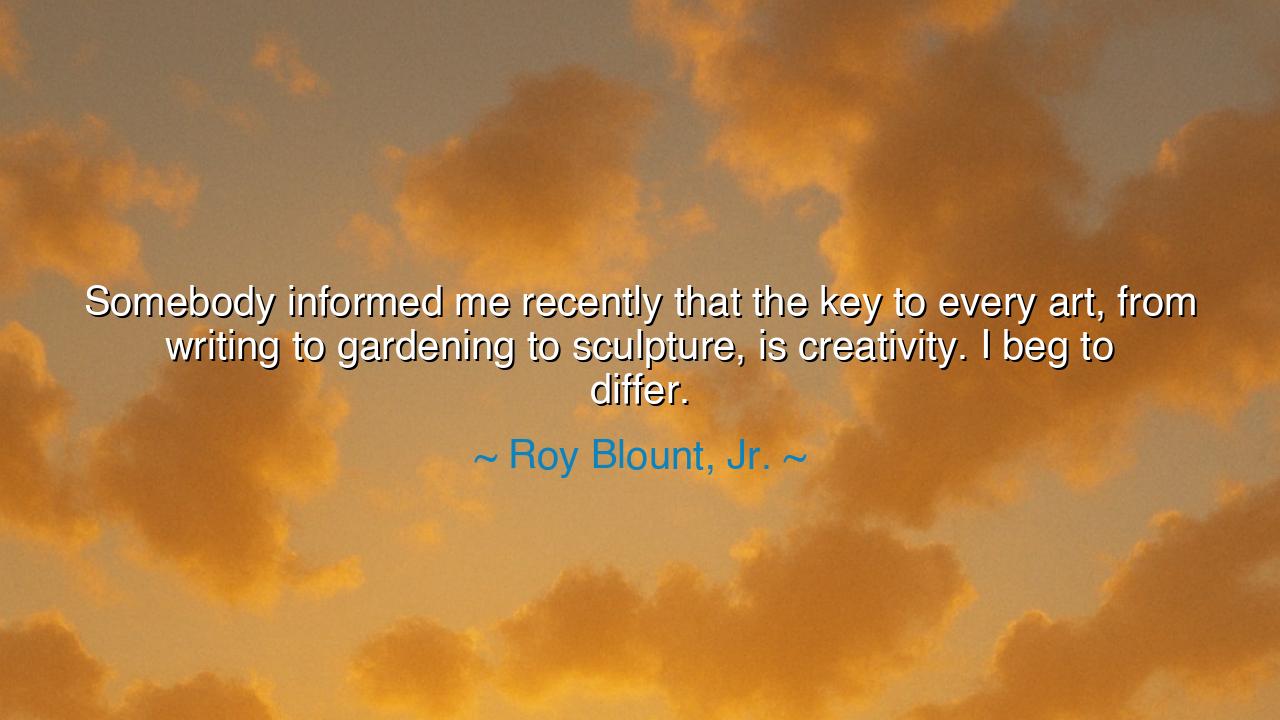
Somebody informed me recently that the key to every art, from
Somebody informed me recently that the key to every art, from writing to gardening to sculpture, is creativity. I beg to differ.






“Somebody informed me recently that the key to every art, from writing to gardening to sculpture, is creativity. I beg to differ.” — in these sharp yet humble words, Roy Blount, Jr., the American humorist and essayist, offers not a denial of creativity, but a profound correction to how we understand it. His is the wisdom of one who has looked beyond the glitter of invention to the deeper soil from which all art truly grows — patience, discipline, observation, and heart. When he says, “I beg to differ,” he is not rejecting the value of creativity; he is reminding us that it is not the beginning, but the fruit — not the cause of mastery, but its reward.
The origin of this quote rests in Blount’s lifelong exploration of language, humor, and the human condition. A writer of wit and warmth, he has always drawn from the ordinary, finding music in the mundane and truth in the trivial. In his observation, he pushes against the modern tendency to romanticize genius — to believe that brilliance springs from inspiration alone. For him, the key to art — whether in writing, gardening, or sculpture — is not some divine spark that descends upon the chosen few, but the quiet, persistent labor of those who show up, listen deeply, and learn the world’s rhythm. He speaks as one who knows that mastery is born not of flashes of brilliance, but of endless devotion.
To understand his meaning, we must look beyond the word “creativity” and ask what sustains it. The gardener does not create the seed, nor command the rain — he works with what exists, tending, pruning, waiting. The sculptor does not invent the stone; he reveals what is already within it. The writer does not create language from nothing; he listens to its music and gives it form. In all these crafts, the true key is attention — the humility to serve the material, rather than to dominate it. The greatest artist is not the one who imagines most, but the one who sees most clearly. And from that seeing — from that deep union of mind, hand, and heart — creativity blooms naturally, like a flower emerging from well-tended ground.
The ancients understood this long before our age of restless innovation. The Greek sculptor Phidias, whose hand shaped the statue of Zeus — one of the Seven Wonders of the World — did not claim divine originality. He said instead that he followed the laws of proportion and grace, as laid down by nature herself. Likewise, in ancient China, the poet Du Fu described his art not as invention, but as refinement: to polish words as one polishes jade, until their inner radiance appears. Even the philosopher Aristotle taught that art is not born from chaos, but from imitation and discipline — the human attempt to echo the harmony of the cosmos. These masters, like Blount, remind us that art begins not in the self, but in service — service to truth, to craft, to the quiet patterns of the world.
Consider the story of Michelangelo, standing before a massive block of marble that others had deemed worthless. When asked how he would create his David, he replied, “I saw the angel in the marble, and I carved until I set him free.” This, too, echoes Blount’s wisdom. Michelangelo did not impose his imagination upon the stone; he uncovered what was already waiting within it. His genius was not in creation alone, but in perception — the sacred act of seeing what others overlook. The same holds for the gardener who coaxes life from barren soil or the writer who finds beauty in the rhythm of common speech. Their work is not to invent, but to listen — to discern the divine possibilities hidden in the ordinary.
Blount’s “begging to differ” is, therefore, an act of humility against the arrogance of modern artifice. He reminds us that creativity, without grounding, becomes vanity — a noise disconnected from life’s music. The artist, the gardener, the craftsman — they are all, at their core, servants of order and beauty. They labor in silence, guided not by the hunger for novelty, but by love for their materials. To create well is to surrender — to let the work teach you what it wants to be. True art is less a performance of genius and more a conversation with the eternal.
So, my child, take this lesson to heart: do not chase creativity — cultivate it. Plant your seeds in patience. Hone your craft through repetition. Observe before you invent, and honor what already exists. The world does not ask for constant novelty; it asks for care. When you shape your work with attention and humility, creativity will arise on its own, like dawn following the night — inevitable, unforced, and full of grace.
And remember the teaching of Roy Blount, Jr.: that to master any art — whether of writing, gardening, or living — one must learn not merely to create, but to listen. For all true creation begins with reverence: the willingness to kneel before the mystery of the world, to touch it gently, and to let it shape you as much as you shape it. Then, and only then, will your work — like the garden, the sculpture, the poem — live and breathe with the quiet perfection of something that belongs to both heaven and earth.






AAdministratorAdministrator
Welcome, honored guests. Please leave a comment, we will respond soon